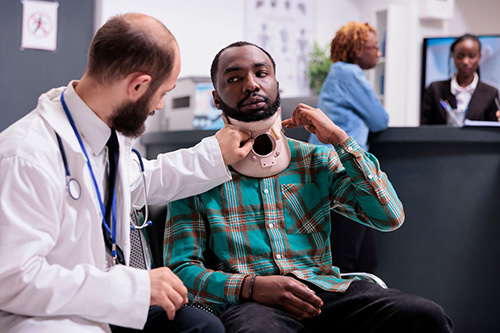
South Carolina Workers’ Compensation for Tendonitis
Learn about your right to compensation after a tendonitis injury at work
Tendonitis is a common occupational injury that affects workers across many industries in South Carolina. It’s considered an “overuse” or “repetitive stress” injury that’s characterized by the inflammation and irritation of tendons, which can cause pain, swelling and limited mobility.
Tendonitis can significantly impact an individual’s ability to perform their job duties and may require medical treatment and time off work for recovery. Being able to recognize the signs of tendonitis and connect them to your work duties can help you begin the process of recovering compensation to help with your recovery.
What is tendonitis?
Tendons are strong cords that connect muscles to their nearby bones. Since tendons exist throughout your body, you can develop tendonitis just about anywhere. The wrists, elbows, fingers and shoulders tend to be the most common areas where you’ll see tendonitis develop.
The condition differs from many other types of workplace injuries because it occurs slowly over time. While it’s relatively easy to link the cause of a broken arm to a specific accident that happened at work, it tends to be a little harder to prove that tendonitis in the elbow occurred from repetitive stress at a job site.
Today, it’s becoming more common to see tendonitis develop in people who work in a variety of high-risk fields that require repetitive movements, such as construction workers and roofers who constantly swing a hammer or office workers who type all day.
Common symptoms of tendonitis
The symptoms of tendonitis tend to be the same, no matter where the injury occurs in the body. You might notice a dull or aching pain that seems to increase with continued repetitive movements. Pain that seems to appear or get worse when you move a particular joint is indicative of a possible injury in this part of your body. You might also notice some swelling and a limited range of motion in the impacted joint.
How is tendonitis diagnosed?
The location of your pain can play a role in the diagnosis. During a medical exam, a physician may ask you to move the injured part of your body in certain ways to determine the source of your injury, as many repetitive stress injuries have only slight differences in their symptoms but may require different treatments.
For example, lateral epicondylitis, or tennis elbow, will cause pain that affects the backside of your forearm and elbow and occurs along the same side as your thumb when you turn your arm a certain way. Meanwhile, golfer’s elbow tends to hurt more on the palm side of your arm. While these differences may seem minor to you, they can help your physician narrow down the specific movements you’ve been making that may have led to your injury.
A medical professional relies heavily on a physical exam to diagnose an overuse injury, but they may also perform additional tests to rule out other common conditions. Joint aspiration can check for infections or gout. An X-ray can also rule out a broken bone, although it can’t show the tendons.
Causes of tendonitis in the workplace
There are 2 primary causes of tendonitis in the workplace.
The first is engaging in repetitive motions that eventually cause strain on the tendons near the joints. Repetitive bending, lifting and twisting movements generate stress on the tendons, which increases the rate of wear and tear on certain parts of the body.
The second main cause involves using improper techniques to perform these movements. Bending a limb the wrong way can cause excess strain on a tendon that leads to injury, especially if you perform a moment incorrectly multiple times.
What types of workers are most at risk of developing tendonitis?
Tendonitis is a type of injury that can affect workers in almost any industry. Anyone whose job duties require them to make constant repetitive movements throughout the day is at risk, including:
- Delivery drivers who frequently engage in repetitive motions, such as lifting and carrying heavy packages, may also be at risk for developing tendonitis.
- Factory workers and textile workers involved in assembly line work, manufacturing or operating machinery that requires repetitive movements may be prone to tendonitis in various body parts.
- Healthcare professionals like nurses, doctors and other healthcare workers who frequently perform repetitive tasks, such as lifting patients or repetitive hand movements during procedures, are also susceptible to tendonitis.
- Landscapers and gardeners who engage in repetitive tasks such as digging, pruning and operating equipment for prolonged periods can develop tendonitis in their wrists, shoulders and elbows.
- Construction and agricultural workers are often at a higher risk of developing tendonitis due to the heavy work they perform, which often involves using the same repetitive motion to accomplish their duties.
- Retail workers can develop this type of injury from performing the same motions as they scan items at a checkout counter, stock shelves or fold clothing.
- Office workers who work in positions that require a large amount of typing can also tend to develop tendonitis in their wrists and fingers.
Does workers’ compensation cover tendonitis?
The primary treatment for tendonitis includes a period of rest and recovery during which you might not be able to perform your job duties. You may also need extensive physical therapy for tendonitis, which can be costly, especially during a time when you may be facing lost wages.
Fortunately, South Carolina’s workers’ compensation program is designed to help employees manage their financial needs after a workplace injury.
Under South Carolina workers’ comp law, tendonitis is classified as an occupational disease. Occupational diseases are defined as illnesses or conditions that are associated with a particular occupation or industry. Tendonitis and other repetitive stress injuries that develop over a period of time generally fall into this category.
Most workers in South Carolina are eligible for workers’ compensation benefits as long as they’re classified as employees (not independent contractors) and their employer employs 4 or more workers. To get compensation for tendonitis, you don’t need to prove your employer was at fault for your injury, but you will need to prove that your injury was caused by your job duties.
Know your rights and responsibilities:
SC workers’ compensation eligibility
Explore the key factors affecting workers’ comp eligibility, including employee status, the nature of the injury or illness, and reporting and filing deadlines.
How do you prove tendonitis is work-related?
With a repetitive stress injury, you may need to provide different types of documentation to prove the injury was caused by your job, compared to a traumatic, one-time injury that often has clear roots in a single isolated incident.
For instance, you might need a medical professional to demonstrate exactly how your work-related movements put a strain on your tendons. Depending on how long you’ve had the injury, it may also be helpful to provide proof of related medical appointments and treatments to show the progression of the tendonitis to the point that performing your work tasks is no longer manageable.
An experienced workers’ compensation attorney can help you gather evidence to prove your injury is work-related and connect you with medical experts who can testify on your behalf if necessary.
Steps to file a workers’ comp claim in South Carolina
To begin the process of filing a claim, you’ll need to get an official diagnosis. To do this, you’ll need to choose a doctor from a list of providers approved by your employer.
Next, you’ll need to notify your employer within 90 days of realizing that you have a work-related injury. For tendonitis, this typically means within 90 days of receiving a diagnosis.
After you notify your employer, it’s their job to file a claim with their workers’ compensation insurer and notify the South Carolina Workers’ Compensation Commission of your injury. If your claim is denied, don’t get discouraged. You can still reach out to an experienced work injury attorney for help with an appeal.
Types of workers’ comp benefits
If you get approved for worker’s comp benefits, you may be eligible to receive compensation for the following:
- Medical benefits that include compensation for all necessary pain management treatments, medications, doctor’s appointments, surgeries, medical supplies and equipment, and physical and occupational therapy
- Lost wage benefits that include payments of two-thirds of your average weekly wage during your recovery while you’re unable to work
Contact an experienced Columbia work injury attorney
With a tendonitis injury, it’s important to understand that some challenges can arise in proving how the injury relates to your job. You might also face difficulties with an employer who fails to file your claim or offers you far less money than you need for your medical expenses and lost wages. Working with an attorney who is experienced in helping people with tendonitis can increase your chances of a successful resolution for your case.
At Smith, Born, Leventis, Taylor & Vega, we believe that every employee is entitled to a safe work environment. When injuries do occur, you shouldn’t have to worry about how you’re going to afford your medical care or pay your bills. That’s why our Columbia workers’ compensation attorneys offer free, no-obligation consultations to give you the help and information you need to get back on the road to recovery.
Contact us today to see how we can help you get maximum compensation for your claim.

